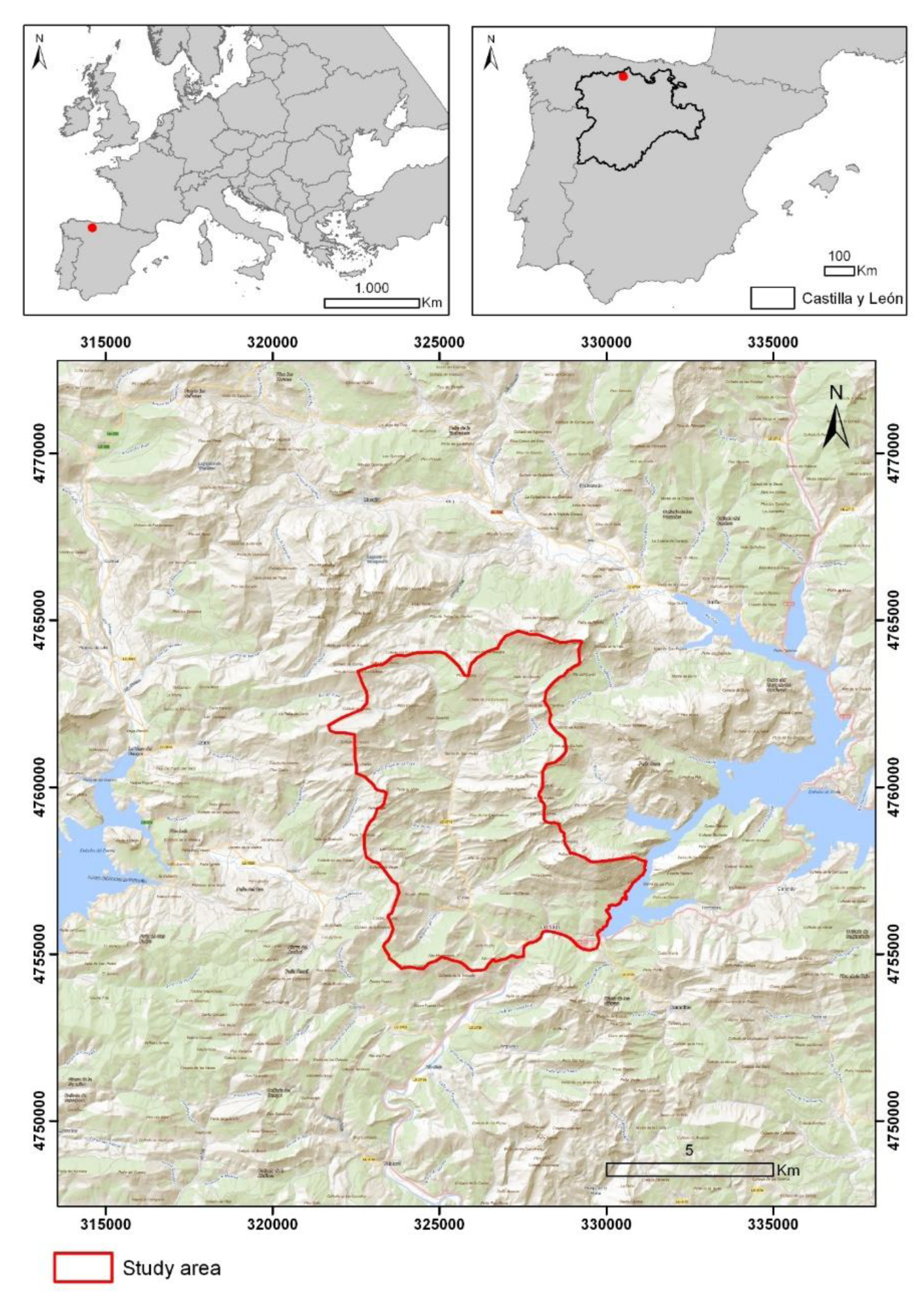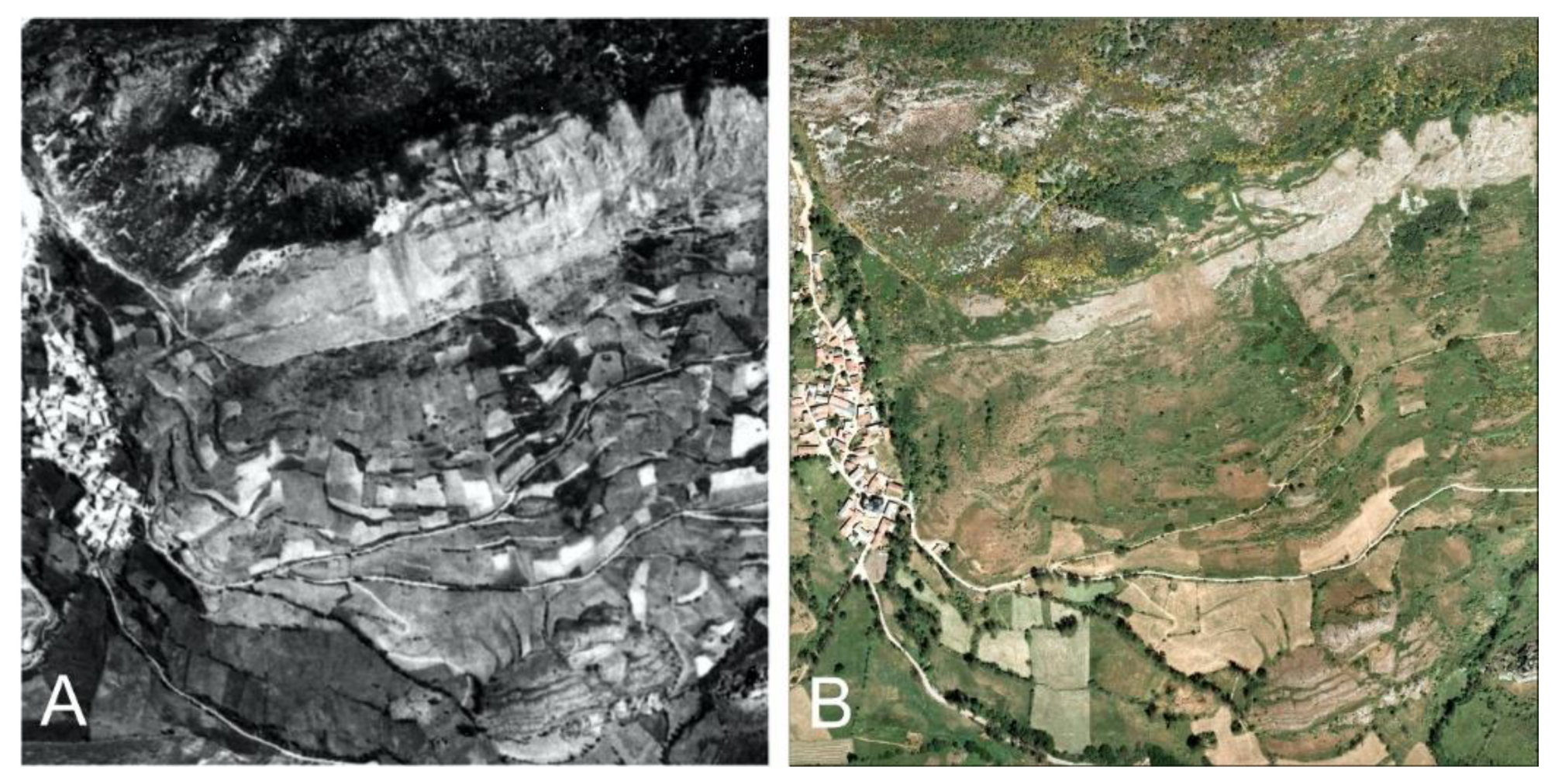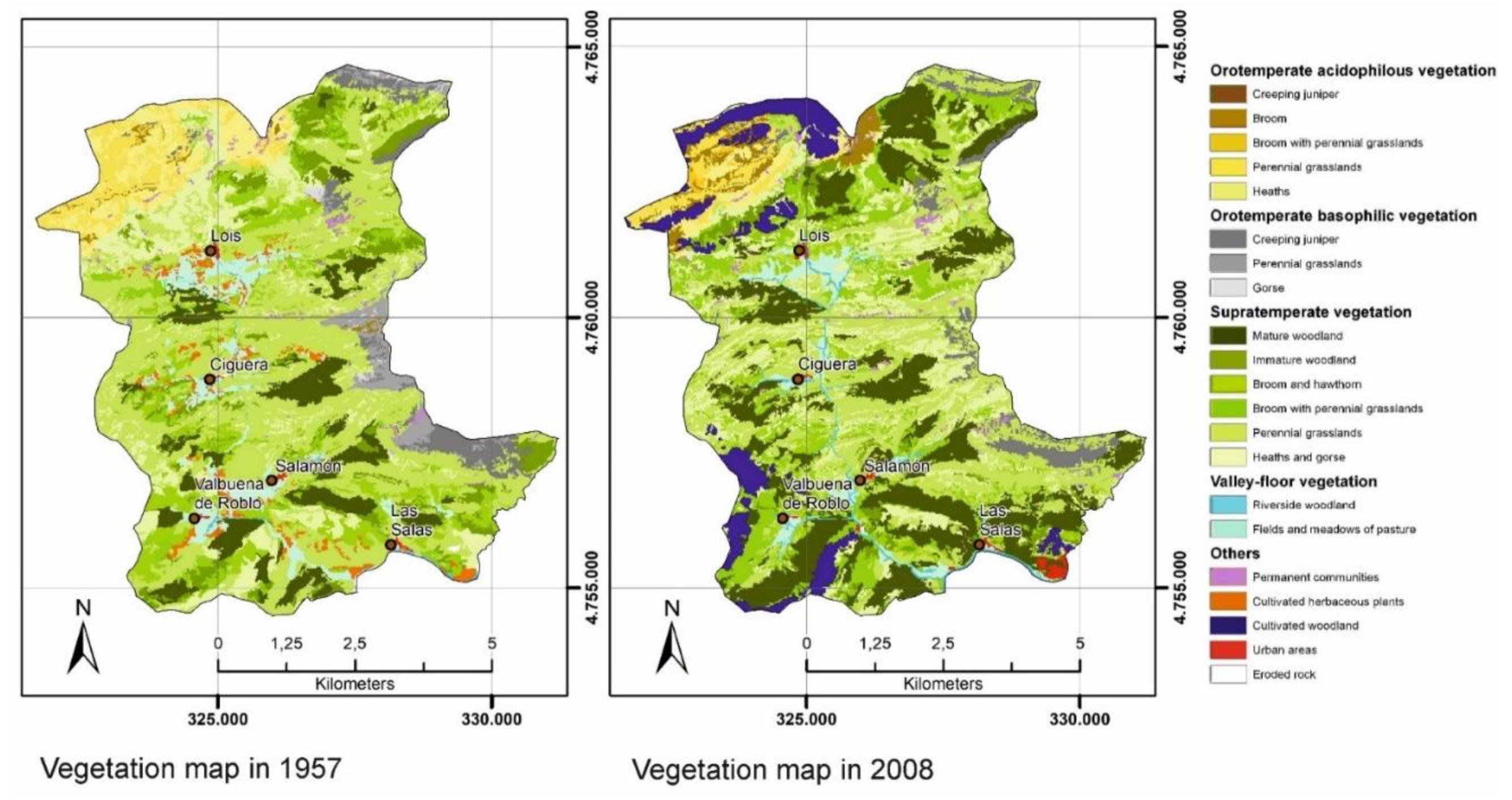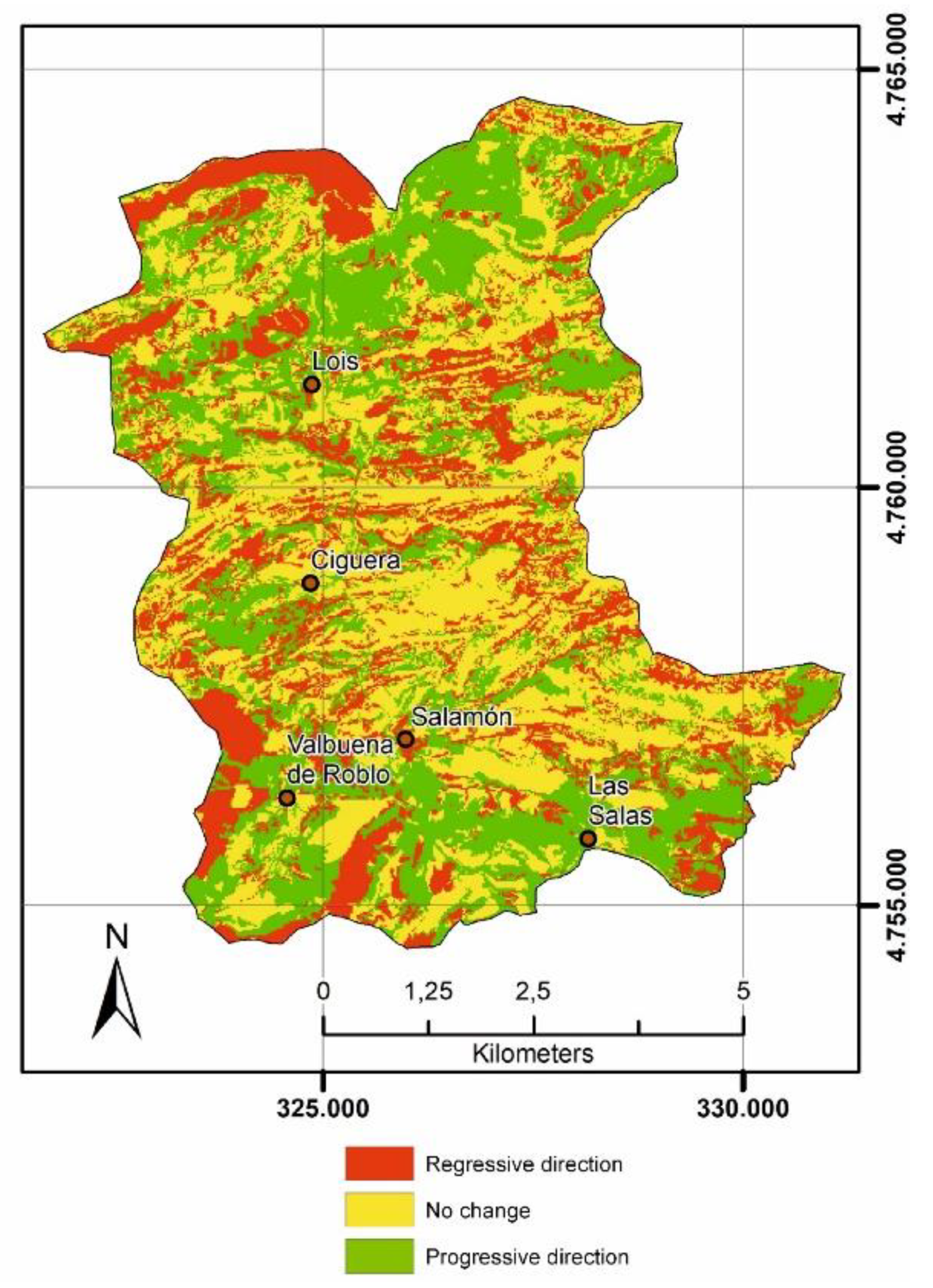Temporal Indices of Landscape Change: A Proposal to Measure Variations in the Conservation Status of Vegetation at Fine Resolution
Abstract
1. Introduction
2. Materials and Methods
2.1. New Proposal: Formulation
2.1.1. Conservation Status Variation Index (ConSVI)
2.1.2. Conservation Status Variation Velocity Index (ConSVVe)
2.1.3. Change Ratio (ChanRat)
2.1.4. An Applied Example of Temporal Change Indices
3. Results
3.1. Calculation of DI, PDIi, and PDIf
3.2. Calculation of the Temporal Indices of Landscape Change: ConSVI, ConSVVe, and ChanRat
3.3. Changes in the Structure of the Vegetation in the Sample Territory
4. Discussion
5. Conclusions
Supplementary Materials
Author Contributions
Funding
Acknowledgments
Conflicts of Interest
References
- De Cáceres, M.; Chytrý, M.; Agrillo, E.; Attorre, F.; Botta-Dukát, Z.; Capelo, J.; Czúcz, B.; Dengler, J.; Ewald, J.; Faber-Langendoen, D.; et al. A comparative framework for broad-scale plot-based vegetation classification. Appl. Veg. Sci. 2015, 18, 543–560. [Google Scholar] [CrossRef]
- Rüdisser, J.; Tasser, E.; Tappeiner, U. Distance to nature—A new biodiversity relevant environmental indicator set at the landscape level. Ecol. Indic. 2012, 15, 208–216. [Google Scholar] [CrossRef]
- Pizzolotto, R.; Brandmayr, P. An index to evaluate landscape conservation state based on land-use pattern analysis and Geographic Information System techniques. Coenoses 1996, 11, 37–44. [Google Scholar]
- Penas, A.; Del Río, S.; Herrero, L. A new methodology for the quantitative evaluation of the conservation status of vegetation: The potentiality distance index (PDI). Fitosociologia 2005, 42, 23–31. [Google Scholar]
- Ferrari, C.; Pezzi, G.; Diani, L.; Corazza, M. Evaluating landscape quality with vegetation naturalness maps: An index and some inferences. Appl. Veg. Sci. 2008, 11, 243–250. [Google Scholar] [CrossRef]
- Biurrun, I.; Bergmeier, E.; Dengler, J.; Jansen, F.; Willner, W. Vegetation classification and its application are relevant globally. Phytocoenologia 2019, 49, 1–6. [Google Scholar] [CrossRef]
- Dengler, J. Phytosociology. In The International Encyclopedia of Geography: People, the Earth, Environment and Technology; Richardson, D., Castree, N., Goodchild, M.F., Kobayshi, A.L., Liu, W., Marston, R., Eds.; Wiley-Blackwell: Chichester, UK, 2017; pp. 1–6. [Google Scholar] [CrossRef]
- Rivas-Martínez, S. Sinfitosociología, una nueva metodología para el estudio del paisaje vegetal. An. Inst. Bot. Cavanilles 1976, 33, 179–188. [Google Scholar]
- Raposo, M.; Conceição-Castro, M.; Gomes, C.P. The application of symphytosociology in landscape architecture. Botanique 2016, 1, 103–112. [Google Scholar]
- Rivas-Martínez, S.; Loidi, J. Bioclimatology of the Iberian Peninsula. Itinera Geobot. 1999, 13, 41–48. [Google Scholar]
- Rivas-Martínez, S.; Díaz, T.E.; Fernández-González, F.; Izco, J.; Loidi, J.; Lousã, M.; Penas, A. Vascular plant communities of Spain and Portugal. Addenda to the syntaxonomical checklist of 2001. Itinera Geobot. 2002, 15, 433–922. [Google Scholar]
- Rivas-Martínez, S.; Penas, A.; Díaz, T.E.; Fernández, F. Mapa de series, geoseries y geopermaseries de vegetación de España. Memoria del mapa de vegetación potencial de España, parte I. Itinera Geobot. 2007, 17, 5–436. [Google Scholar]
- Farina, A. Ecología del Paisaje; Publisher University of Alicante: Alicante, Spain, 2011; pp. 1–668. [Google Scholar]
- Cantoral, A. Assesment of the Influence of the Traditional Management as A Key Element in the Maintenance of Biodiversity and Impact of Its Abandonment in the Conservation of the Mountainous Territory between the Rivers Esla and Porma. Ph.D. Thesis, University of León, León, Spain, 2015. [Google Scholar]
- Bannari, A.; Morin, D.; Bonn, F.; Huete, A.R. A review of vegetation indices. Remote Sens. Rev. 1995, 13, 95–120. [Google Scholar] [CrossRef]
- Sevilla, J.; Rodríguez, C. La dinámica reciente del paisaje del puerto de Leitariegos (montaña occidental asturleonesa) a través de la fotografía aérea. Ería 2015, 98, 241–274. [Google Scholar] [CrossRef]
- Lambin, E.F.; Ehrlich, D. The surface temperature-vegetation index space for land cover and land-cover change analysis. Int. J. Remote Sens. 1996, 17, 463–487. [Google Scholar] [CrossRef]
- Lyon, J.G.; Yuan, D.; Lunetta, R.S.; Elvidge, C.D. A change detection experiment using vegetation indices. Photogramm. Eng. Remote Sens. 1998, 64, 143–150. [Google Scholar]
- Vicente-Serrano, S.M.; Beguería, S.; Lasanta, T. Diversidad espacial de la actividad vegetal en campos abandonados del Pirineo Central español: Análisis de los procesos de sucesión mediante imágenes Landsat (1984–2001). Pirineos 2006, 161, 59–84. [Google Scholar] [CrossRef]
- Hu, M.; Xia, B. A significant increase in the normalized difference vegetation index during the rapid economic development in the Pearl River Delta of China. Land Degrad. Dev. 2019, 30, 359–370. [Google Scholar] [CrossRef]
- Rouse, J.W., Jr.; Haas, R.H.; Schell, J.A.; Deering, D.W. Monitoring vegetation systems in the Great Plains with ERTS. In Third Earth Resources Technology Satellite-1 Symposium. Technical Presentations, Section B; NASA-SP-351-VOL-1-SECT-B, A 20; Freden, S.C., Mercanti, E.P., Becker, M.A., Eds.; NASA: Washington, DC, USA, 1974; Volume 1, pp. 309–317. [Google Scholar]
- Liu, H.Q.; Huete, A. A feedback based modification of the NDVI to minimize canopy background and atmospheric noise. IEEE Trans. Geosci. Remote Sens. 1995, 33, 457–465. [Google Scholar] [CrossRef]
- Dong, T.; Liu, J.; Shang, J.; Qian, B.; Ma, B.; Kovacs, J.M.; Walters, D.; Jiao, X.; Geng, X.; Shi, Y. Assessment of red-edge vegetation indices for crop leaf area index estimation. Remote Sens. Environ. 2019, 222, 133–143. [Google Scholar] [CrossRef]
- Rokni, K.; Musa, T.A. Normalized difference vegetation change index: A technique for detecting vegetation changes using Landsat imagery. Catena 2019, 178, 59–63. [Google Scholar] [CrossRef]
- Meng, Y.; Liu, X.; Wu, L.; Liu, M.; Zhang, B.; Zhao, S. Spatio-temporal variation indicators for landscape structure dynamics monitoring using dense normalized difference vegetation index time series. Ecol. Indic. 2019, 107, 105607. [Google Scholar] [CrossRef]
- Broich, M.; Hansen, M.C.; Potapov, P.; Adusei, B.; Lindquist, E.; Stehman, S.V. Time-series analysis of multi-resolution optical imagery for quantifying forest cover loss in Sumatra and Kalimantan, Indonesia. Int. J. Appl. Earth Obs. 2011, 13, 277–291. [Google Scholar] [CrossRef]
- Whittaker, R.H. Climax concepts and recognition. In Vegetation Dynamics; Springer: Dordrecht, The Netherlands, 1974; pp. 137–154. [Google Scholar]
- ESRI. ArcMap 10; Environmental Systems Research Institute: Redlands, CA, USA, 2010; Available online: https://www.esri.es/arcgis/ (accessed on 6 March 2014).
- Díaz González, T.E.; Prieto, J.F.; García, M.Á.; Pérez, A.F.; Rodríguez, A.G. Tratamiento de los Datos del Inventario de Hábitats Derivado de la DIRECTIVA 92/43/CEE; Consejería de Agricultura. Principado de Asturias: Oviedo, España, 1996. [Google Scholar]
- ITACYL. Fotogramas del Vuelo Americano de 1956-57 Correspondientes a la Cuenca del Duero. Available online: http://ftp.itacyl.es/cartografia/03_FotogramasAereos/Vuelo-Americano_1956-57/ (accessed on 1 December 2012).
- Musick, H.B. Assessment of Landsat multispectral scanner spectral indexes for monitoring arid rangeland. IEEE Trans. Geosci. Remote Sens. 1984, 6, 512–519. [Google Scholar] [CrossRef]
- Zhang, S.; Chen, H.; Fu, Y.; Niu, H.; Yang, Y.; Zhang, B. Fractional Vegetation Cover Estimation of Different Vegetation Types in the Qaidam Basin. Sustainability 2019, 11, 864. [Google Scholar] [CrossRef]
- Torta, G. Consequences of rural abandonment in a Northern Apennines Landscape (Tuscany, Italy). In Recent Dynamics of the Mediterranean Vegetation and Landscape; Mazzoleni, S., Di Pasquale, G., Mulligan, M., Martinio, P., Di Rego, F., Eds.; Wiley and Sons Ltd: Chichester, UK, 2004; pp. 157–167. [Google Scholar]
- Lasanta-Martínez, T.; Vicente-Serrano, S.M.; Cuadrat-Prats, J.M. Mountain Mediterranean landscape evolution caused by the abandonment of traditional primary activities: A study of the Spanish Central Pyrenees. Appl. Geogr. 2005, 25, 47–65. [Google Scholar] [CrossRef]
- García-Llamas, P.; Geijzendorffer, I.R.; García-Nieto, A.P.; Calvo, L.; Suárez-Seoane, S.; Cramer, W. Impact of land cover change on ecosystem service supply in mountain systems: A case study in the Cantabrian Mountains (NW of Spain). Reg. Environ. Chang. 2019, 19, 529–542. [Google Scholar] [CrossRef]
- Plieninger, T.; Kizos, T.; Bieling, C.; Dû-Blayo, L.; Budniok, M.; Bürgi, M.; Crumley, C.; Girod, G.; Howard, P.; Kolen, J. Exploring ecosystem-change and society through a landscape lens: Recent progress in European landscape research. Ecol. Soc. 2015, 20, 5–10. [Google Scholar] [CrossRef]
- Lavorel, S.; Grigulis, K.; Leitinger, G.; Kohler, M.; Schirpke, U.; Tappeiner, U. Historical trajectories in land use pattern and grassland ecosystem services in two European alpine landscapes. Reg. Environ. Chang. 2017, 17, 2251–2264. [Google Scholar] [CrossRef]
- Paruelo, J.M.; Garbulsky, M.F.; Guerschman, J.P.; Jobbágy, E.G. Two decades of Normalized Difference Vegetation Index changes in South America: Identifying the imprint of global change. Int. J. Remote Sens. 2004, 25, 2793–2806. [Google Scholar] [CrossRef]
- Li, J.; Peng, S.; Zhi, L. Detecting and attributing vegetation changes on China’s Loess Plateau. Agric. For. Meteorol. 2017, 247, 260–270. [Google Scholar] [CrossRef]




| PDI | Distance to the Head of Series | Conservation Status |
|---|---|---|
| ≤0.25 | Very distant | Poor |
| 0.25–0.50 | Distant | Moderate |
| 0.50–0.75 | Moderately distant | Good |
| >0.75 | Not very distant/Not distant | Very good |
| ConSVI Scores | Variation in Conservation Status |
|---|---|
| −1 to −0.5) | Highly negative |
| −0.5 to −0.25) | Negative |
| −0.25 to 0 | Moderately negative |
| 0 | Neutral |
| 0 to 0.25 | Moderately positive |
| 0.25 to 0.5 | Positive |
| 0.5 to 1 | Highly positive |
| ConSVVe Scores | Variation in Conservation Status Over a Unit of Time |
|---|---|
| −1 to −0.5) | Rapid degradation |
| −0.5 to −0.25) | Moderate degradation |
| −0.25 to 0 | Slow degradation |
| 0 | Neutral |
| 0 to 0.25 | Slow recovery |
| 0.25 to 0.5 | Moderate recovery |
| 0.5 to 1 | Rapid recovery |
| 1957 | 2008 | |||||||
|---|---|---|---|---|---|---|---|---|
| Types of Vegetation | P | n | NI | DI | Ωi (ha) | DI × (Ωi/ΩT) | Ωi (ha) | DI × (Ωi/ΩT) |
| Azonal Communities | ||||||||
| Permanent orotemperate communities | 1 | 1 | 3 | 1 | 12.04 | 0.0022 | 10.2 | 0.0018 |
| Permanent supratemperate communities | 1 | 1 | 3 | 1 | 32.48 | 0.0058 | 42.88 | 0.0077 |
| Basophilic creeping juniper | 1 | 1 | 3 | 1 | 85.6 | 0.0153 | 83.32 | 0.0150 |
| Orotemperate acidophilous vegetation | ||||||||
| Creeping juniper | 1 | 4 | 3 | 1 | 2.16 | 0.0004 | 4.36 | 0.0008 |
| Broom | 2 | 4 | 3 | 0.75 | 24.72 | 0.0033 | 120.8 | 0.0163 |
| Broom with Orocantabrian oak | 1 | 1 | 3 | 1 | 0 | 0 | 3.2 | 0.0006 |
| Broom with perennial grasslands | 2 | 4 | 1 | 0.58 | 1.56 | 0.0002 | 11.92 | 0.0012 |
| Perennial grasslands | 3 | 4 | 3 | 0.5 | 211.48 | 0.0190 | 114.88 | 0.0103 |
| Heaths | 4 | 4 | 2 | 0.17 | 266.64 | 0.0080 | 99.28 | 0.0030 |
| Cultivated woodland | 8 | 8 | 1 | 0.04 | 0 | 0 | 153.68 | 0.0012 |
| Orotemperate basophilic vegetation | ||||||||
| Creeping juniper | 1 | 3 | 3 | 1 | 96.52 | 0.0174 | 95.12 | 0.0171 |
| Perennial grasslands | 2 | 3 | 3 | 0.67 | 153.84 | 0.0184 | 134.44 | 0.0161 |
| Gorse | 3 | 3 | 2 | 0.22 | 16 | 0.0006 | 37.12 | 0.0015 |
| Supratemperate vegetation | ||||||||
| Mature woodland | 1 | 7 | 3 | 1 | 436.12 | 0.0784 | 1181.88 | 0.2125 |
| Immature woodland | 1 | 7 | 1 | 0.90 | 375.64 | 0.0611 | 152.28 | 0.0248 |
| Broom and hawthorn | 3 | 7 | 2 | 0.67 | 293.92 | 0.0352 | 604.72 | 0.0725 |
| Broom with perennial grasslands | 3 | 7 | 1 | 0.62 | 341.2 | 0.0380 | 164.6 | 0.0183 |
| Perennial grasslands | 4 | 7 | 2 | 0.52 | 2186.36 | 0.2059 | 1376.36 | 0.1296 |
| Heaths and gorse | 5 | 7 | 2 | 0.38 | 597.48 | 0.0409 | 734.64 | 0.0503 |
| Eroded rock | 7 | 7 | 1 | 0.05 | 5.36 | 0 | 1.6 | 0 |
| Urban areas | 8 | 8 | 1 | 0.04 | 10.76 | 0.0001 | 25.6 | 0.0002 |
| Cultivated woodland | 8 | 8 | 1 | 0.04 | 0 | 0 | 200.8 | 0.0015 |
| Cultivated herbaceous plants | 8 | 8 | 1 | 0.04 | 244.24 | 0.0018 | 0.44 | 0 |
| Valley-floor vegetation | ||||||||
| Riverside woodland | 1 | 5 | 1 | 0.87 | 15.16 | 0.0024 | 61.12 | 0.0095 |
| Fields and meadows of pasture | 4 | 5 | 2 | 0.33 | 151.2 | 0.0091 | 146.52 | 0.0088 |
| Bodies of water | - | - | - | - | 2.16 | - | 0.92 | - |
| ΩT = 5562.68 | PDIi = 0.5636 | ΩT = 5562.68 | PDIf = 0.6205 | |||||
| Indices | Abbreviation | Score |
|---|---|---|
| Initial indices | ||
| Potentiality Distance Index, 1957 | PDIi | 0.5636 |
| Potentiality Distance Index, 2008 | PDIf | 0.6205 |
| Temporal change indices | ||
| Conservation Status Variation Index | ConSVI | 0.0569 |
| Conservation Status Variation Velocity | ConSVVe | 0.0112 |
| Conservation Status Change Ratio (%) | ChanRat | 1.9813 |
| Types of Vegetation | Land Cover Change (ha) | Rate of Change (%) | Stability (%) | Regression (%) | Progression (%) |
|---|---|---|---|---|---|
| Azonal communities | |||||
| Permanent orotemperate communities | −1.84 | −15.28 | 72.42 | 27.57 | 0 |
| Permanent supratemperate communities | 10.4 | 32.02 | 88.92 | 10.22 | 0 |
| Basophilic creeping juniper | −2.28 | −2.66 | 55.33 | 42.80 | 0 |
| Orotemperate acidophilous vegetation | |||||
| Creeping juniper | 2.2 | 0 | 3.70 | 96.3 | 0 |
| Broom | 96.08 | 0 | 53.88 | 39.48 | 6.63 |
| Broom with Orocantabrian oak | 3.2 | - | - | - | - |
| Broom with perennial grasslands | 10.36 | 664.10 | 0 | 30.77 | 69.23 |
| Perennial grasslands | −96.6 | −45.68 | 38.30 | 32.70 | 28.99 |
| Heaths | −167.4 | −62.77 | 25.31 | 41.14 | 33.54 |
| Cultivated woodland | 153.68 | - | - | - | - |
| Orotemperate basophilic vegetation | |||||
| Creeping juniper | −1.4 | −1.45 | 56.61 | 43.30 | 0 |
| Perennial grasslands | −19.4 | −12.61 | 59.41 | 16.48 | 23.66 |
| Gorse | 21.12 | 132 | 58.75 | 0 | 41.25 |
| Supratemperate vegetation | |||||
| Mature woodland | 745.76 | 171 | 86.92 | 12.74 | 0 |
| Immature woodland | −223.36 | −59.46 | 5.79 | 16.62 | 77.58 |
| Broom and hawthorn | 310.8 | 105.74 | 24.99 | 22.56 | 52.45 |
| Broom with perennial grasslands | −176.6 | −51.76 | 7.63 | 35.26 | 57.06 |
| Perennial grasslands | −810 | −37.05 | 48.68 | 23.29 | 27.32 |
| Heaths and gorse | 137.16 | 22.96 | 28.73 | 18.50 | 52.76 |
| Eroded rock | −3.76 | −70.15 | 0 | 33.58 | 66.42 |
| Urban areas | 14.84 | 137.92 | 100 | 0 | 0 |
| Cultivated woodland | 200.8 | - | - | - | - |
| Cultivated herbaceous plants | −243.8 | −99.82 | 0 | 0 | 99.93 |
| Valley-floor vegetation | |||||
| Riverside woodland | 45.96 | 303.17 | 50.66 | 49.34 | 0 |
| Fields and meadows of pasture | −4.68 | −3.09 | 31.00 | 29.36 | 39.63 |
| Bodies of water | −1.24 | −57.41 | 0 | 0 | 0 |
© 2019 by the authors. Licensee MDPI, Basel, Switzerland. This article is an open access article distributed under the terms and conditions of the Creative Commons Attribution (CC BY) license (http://creativecommons.org/licenses/by/4.0/).
Share and Cite
Cantoral, A.L.; Alfaro, E.; Alonso-Redondo, R.; García-González, M.E. Temporal Indices of Landscape Change: A Proposal to Measure Variations in the Conservation Status of Vegetation at Fine Resolution. Sustainability 2019, 11, 5887. https://doi.org/10.3390/su11215887
Cantoral AL, Alfaro E, Alonso-Redondo R, García-González ME. Temporal Indices of Landscape Change: A Proposal to Measure Variations in the Conservation Status of Vegetation at Fine Resolution. Sustainability. 2019; 11(21):5887. https://doi.org/10.3390/su11215887
Chicago/Turabian StyleCantoral, Alberto Luis, Estrella Alfaro, Raquel Alonso-Redondo, and Marta Eva García-González. 2019. "Temporal Indices of Landscape Change: A Proposal to Measure Variations in the Conservation Status of Vegetation at Fine Resolution" Sustainability 11, no. 21: 5887. https://doi.org/10.3390/su11215887
APA StyleCantoral, A. L., Alfaro, E., Alonso-Redondo, R., & García-González, M. E. (2019). Temporal Indices of Landscape Change: A Proposal to Measure Variations in the Conservation Status of Vegetation at Fine Resolution. Sustainability, 11(21), 5887. https://doi.org/10.3390/su11215887





